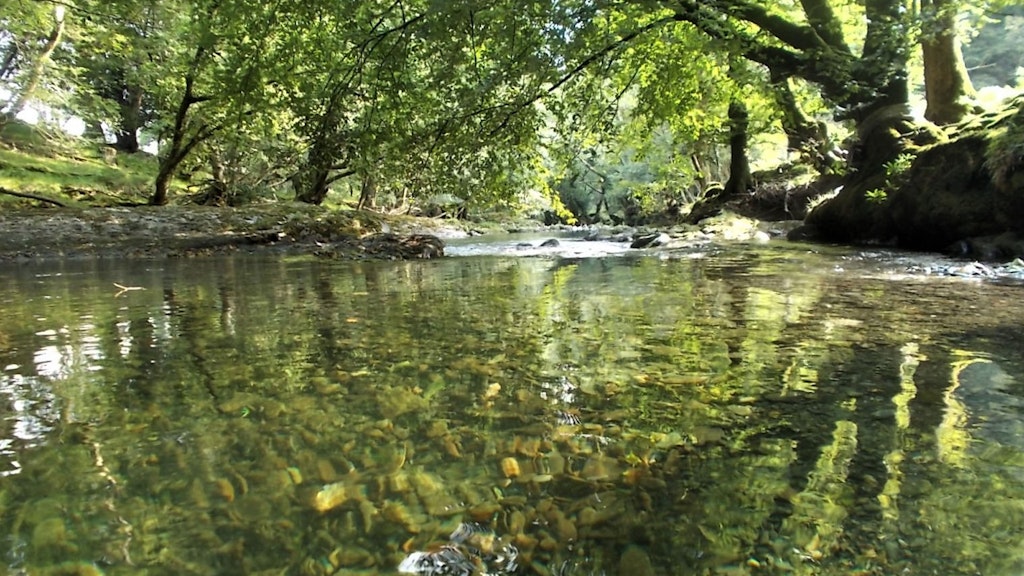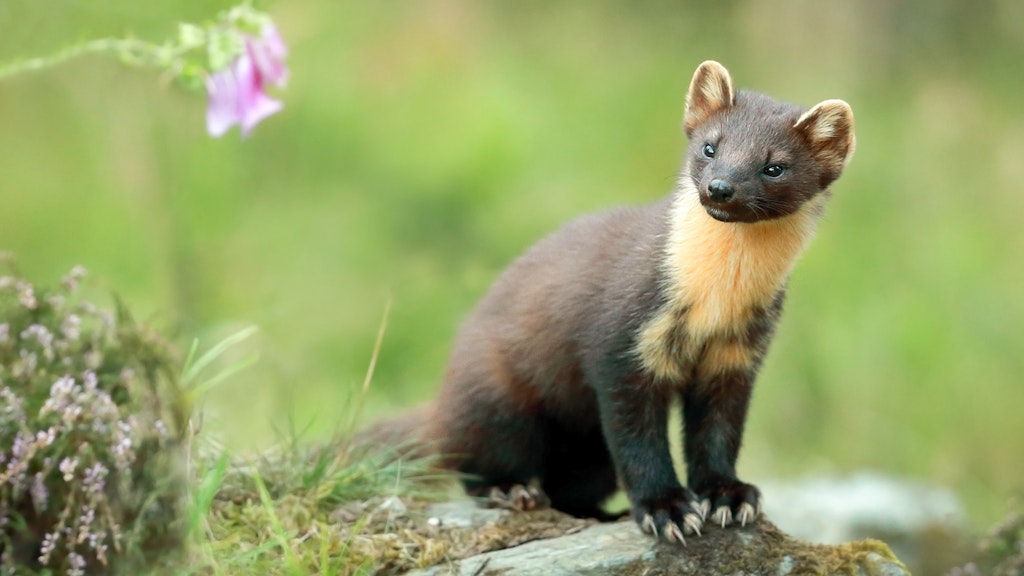
In a small pocket of neglected woodland near CAT, a huge cast of characters have been caught on film. Julie Brominicks celebrates the wildlife of Mid Wales and explores what we can do to help nature thrive.
Originally published in our member’s magazine Clean Slate 118 – Winter 2020
Barely audible or visible, the stream is a mere ripple of light down the bank to my left, and the still air is wet, with a hint of autumnal decay. Suddenly, a yellow goat willow leaf falls with apparent purpose to join the others already decorating a young self-seeded Douglas fir. An hour passes. A full hour, in which the falling leaf and a distant robin’s alarm call have been pretty much it for the action. You might think it a desolate spot.
You might even assume, as I once did, that this pocket of woodland is lifeless. It’s a neglected patch right enough – a fragment of old estate (not far from Coed Gwern, CAT’s woodland) where, at some point in the twentieth century, conifers were planted on a steep slope between streams that flow into Afon Dulas, the river that flows past CAT.
Now rhododendron has crept in, and beneath a dozen dark Douglas Firs, the duff floor is soft as stale bran flakes. A spindly stand of Norway spruce survives somehow on boggy ground and a few western red cedars, Wellingtonia and noble firs snaffle the light. The goat willow, like one or two other straggly broadleafs, struggles for expression between the conifers. But this abandoned pocket is more alive than it seems.

Return of the native
Over the last two years, a wildlife camera strapped to one or other of the trees here has given us enough footage of a pine marten (sometimes two pine martens) to break my laptop. And not just pine martens either – but more of the rest later.
Pine martens have been rippling through my mind since 2008, when barely anyone knew what they were, and I spotted one on the track half a mile from the conifer pocket.
Nowadays, pine marten sightings are increasingly common thanks to a reintroduction programme by the Vincent Wildlife Trust (VWT) who orchestrated the translocation of some fifty pine martens from Scotland to Wales over a three-year period. These animals have swelled the extant Welsh population which was too small and scattered due to historic persecution and habitat loss, to survive without intervention. As volunteers, my husband and I were equipped with a camera by VWT, to help monitor the project’s success.
Within two weeks we had footage of a sleek chestnut mammal with a buttery bib, elfin face and liquid black eyes. Over and again we watched it, and we are no less enchanted now, despite the deluge of footage. The camera has revealed pine martens marking trees with scent glands on their bellies. (Once I arrived in the conifer patch to find the air aromatic as Christmas, like a cinnamon scented candle.) We have watched footage of pine martens alighting on branches that appear too fragile to support them. Pine martens frisking their tails, akin to how red squirrels communicate. Pine martens climbing trees, or descending head first.
Pine martens guzzling the pears we leave on a stick. Pine martens taking eggs we wedge in a crevice (to cache somewhere nearby in a den – they favour mature trees with cavities), with a delicate manner at odds with their fearsome canine teeth. It is this consummate grace that bewitches me most. The movement of these predators whose omnivorous diet includes birds, voles and grey squirrels, is dainty. They climb, bound, jump and run, but mostly they seem to ripple.
Pine martens are not the only mustelid in the valley. Weasels we’ve seen once or twice in the scrub. Badgers snuffle through the conifers on their way to richer foraging grounds. We have caught them on camera, busying along the track made by their frequent passage. Otters, while not resident, do make occasional forays upstream from Afon Dulas, and have left their spraint on rocks within sight of the conifers. In autumn, they fish for salmon in the falls at Ceinws, just a mile from CAT. Last summer we saw one in Pantperthog, not far from our stream’s outlet, near Coed Gwern. We were drying ourselves after a dip when it swam past with the current, mid-stream, two feet deep but lucid, limbs tucked in, serpentine and bubble-veiled.

Enchanted encounters
Back in the conifer pocket, the camera has revealed a fox (the pine marten’s only remaining British predator, save for golden eagles), and a proliferation of grey squirrels, bank voles and wood mice enjoying the fruit and nuts we leave out whilst simultaneously avoiding becoming dinner themselves. Wood mice have at times been prolific, especially in autumn, when they cache food for winter. I have more than once sat through some fifty short films of wood mice – only to find the camera batteries have expired before the pine marten rocked up. But mice too, are fascinating, as they shimmy up several metres of conifer trunk. Who knew they climbed so high?
Birds, it seems, are regular visitors to the conifer pocket. On my way there, I’ve disturbed tree creepers climbing ivytwined ash, bullfinch and goldcrests in the scrub, buzzards, ravens, woodcocks, and a sparrowhawk at speed. But most of the birds caught on camera – blackbirds, robins, song thrush, wrens, great tits and pied flycatchers (in early summer), apparently wait for me to leave before making an appearance.
Jays (aptly named sgrech y coed – ‘screech of the woods’ in Welsh), are abundant in this valley, due largely to the acorns of sessile and pedunculate oaks. Yet despite their vociferous cackling, a flash of blue and white is generally all we see. Fix an apple to a stick in the conifer pocket however, and the camera grants us a good look at their resplendent pink and dazzling blue plumage.
My favourite avian visitor has been a tawny owl negotiating a root ball as carefully as Professor Yaffle climbing a pile of books. But the one that left me breathless was a goshawk. We had seen large birds circling high overhead in spring and wondered. Then in late March this year, as if to defy lockdown, one turned up on camera, and stayed moments on a prostrate trunk, long enough to beguile us with its steely gaze and striped trousers, before powerfully taking off. I saw them for real in May, whilst photographing bluebells. The pair cruised over my shoulder, looking this way and that, using the gap between trees carved out by the stream, tilting their wings like fighter jets.
The camera in the conifer pocket
The camera has revealed a diversity of life we hadn’t known was there. Although nothing can beat a real life encounter with wildlife – the 2008 sighting of a pine marten is still more precious to me than two-years worth of footage – the camera has opened our eyes and enriched our knowledge. We tread more carefully, more appreciatively, now. And though we know we are seeing just a fraction of what biodiversity was once here and even what could be here again, if more woodland was planted across Britain, and ancient woodland and struggling species restored, nevertheless it is thrilling, and cause for celebration – though not one to be taken for granted.
A mosaic of landscape
The presence of life in the conifer pocket is complex. While conifer plantations tend to be species-poor in comparison to mixed woodland, birds like siskin, crossbills, goldcrest, firecrest, and goshawks do benefit from a mosaic of landscape which includes conifer plantations, particularly well-managed ones. This pocket is not well managed.
The species within owe much to its small size and surrounding landscape. The stream’s watershed includes vast spongy grasslands at the foot of Tarren y Gesail, commercial conifer plantation, rough sheep-grazed pasture, steep sessile oak woodland, and a vertiginous rockwalled gorge. The valley downstream of the gorge is largely mixed woodland – beech, sessile oak, ash, rowan, sycamore and holly opposite the conifers, while downstream, young larch, birch, beech, oak, horse chestnut and wild cherry have been planted around morsels of ancient woodland – a creaky old oak or hazel coppice stool here, a straggling wych elm there. Other indicators of ancient woodland include dog’s mercury, bluebells, wild garlic, wood anemones, hard ferns and scaly male fern.
There are no plans I know of to restore the conifer pocket to ancient woodland. Nor do I know of any plans to harvest its timber, though I could be wrong. Meanwhile, its proximity to the stream acidification of soil, dominion over native species and the biodiversity they support, are concerning. But its inappropriate siting isn’t without advantage. There is no vehicle access. The spruce is so spindly, the boggy wet ground beneath is richly cushioned by moss, ivy, ferns and wood sorrel. Storms frequently topple the conifers on steep slopes, and the trees on which we fix the camera are surrounded by a theatre of root balls and prostrate moss-clad and fungied trunks, felled like giant spillikins. In short, the plantation has not entirely stopped the light getting in, allowing old seed banks to germinate. A glimpse of the past, a vision of the future Woodland stores carbon, cleans the air, controls flooding, provides us with timber, benefits our own mental and physical well-being, and should be wildlife rich.
When the glaciers retreated at the end of the last Ice Age, most of Britain became gradually covered with biodiverse woodland, punctuated by areas of scrub and grassland kept in a state of flux by herds of grazing herbivores. The woodland was not continuous, and didn’t grow on the highest peaks. Nevertheless it covered most of Britain, till Neolithic peoples began the process of woodland clearance to grow crops and graze livestock that continues to this day. Now the UK has just 13 percent woodland cover, and is one of the most tree-impoverished and biodiversity-poor countries in Europe. One third of all woodland species are in decline, with one in ten at risk of extinction.
About the author
Former CAT education officer Julie Brominicks (married to and not to be confused with CAT’s cryptic crossword setter Brominicks), still lives in Pantperthog. She now writes about landscape for a living, mainly for BBC Countryfile Magazine. Keep your eyes peeled for her book ‘The Edge of Cymru’, out soon(ish). www.juliebrominicks.wordpress.com
- News Feed
- Autumnwatch
Related Topics
Related Pages
Related events


Zero Carbon Britain: Carbon Literacy for Communities Online
17th June 2025EMAIL SIGN UP
Keep up to date with all the latest activities, events and online resources by signing up to our emails and following us on social media. And if you'd like to get involved and support our work, we'd love to welcome you as a CAT member.
